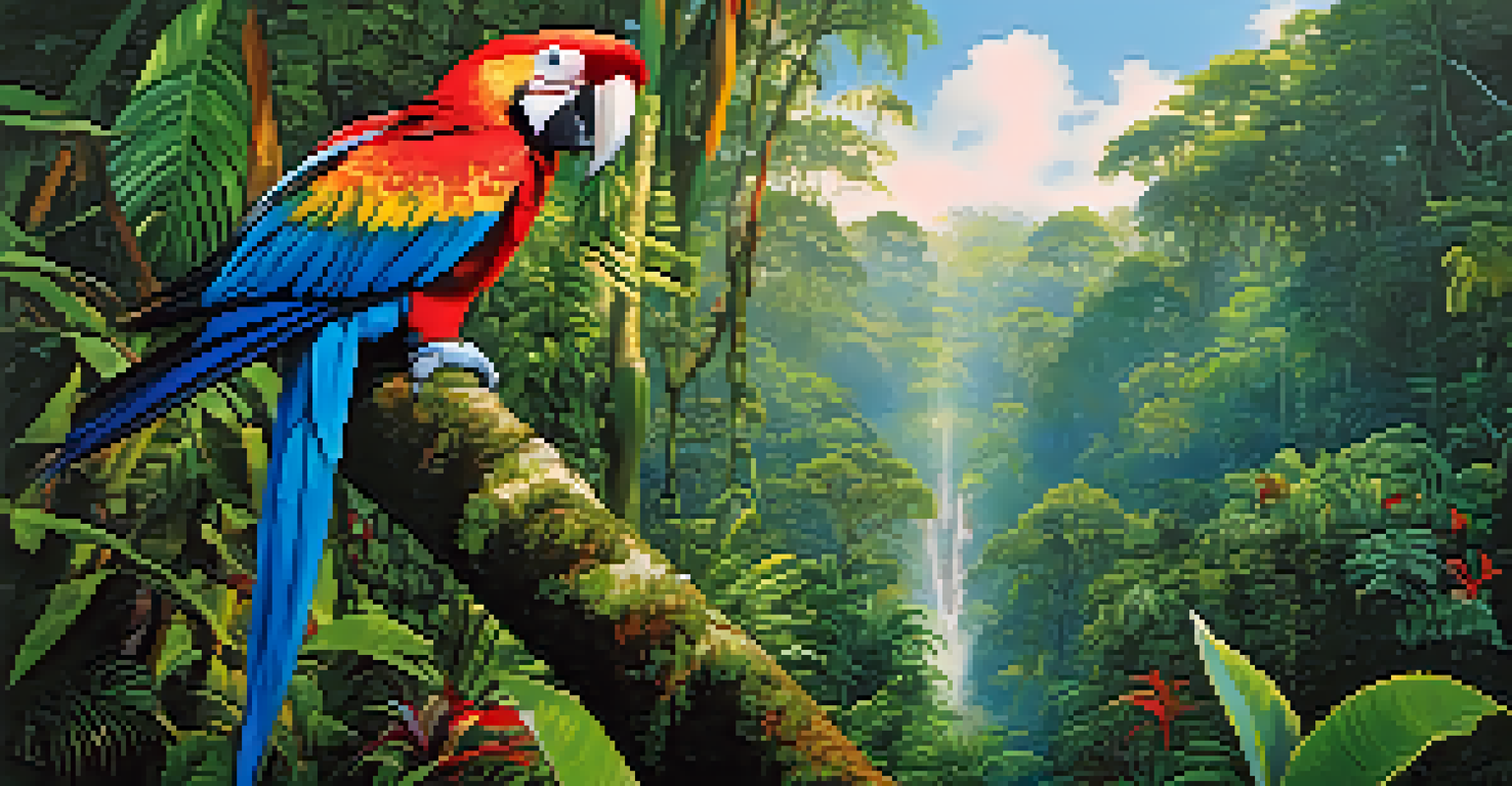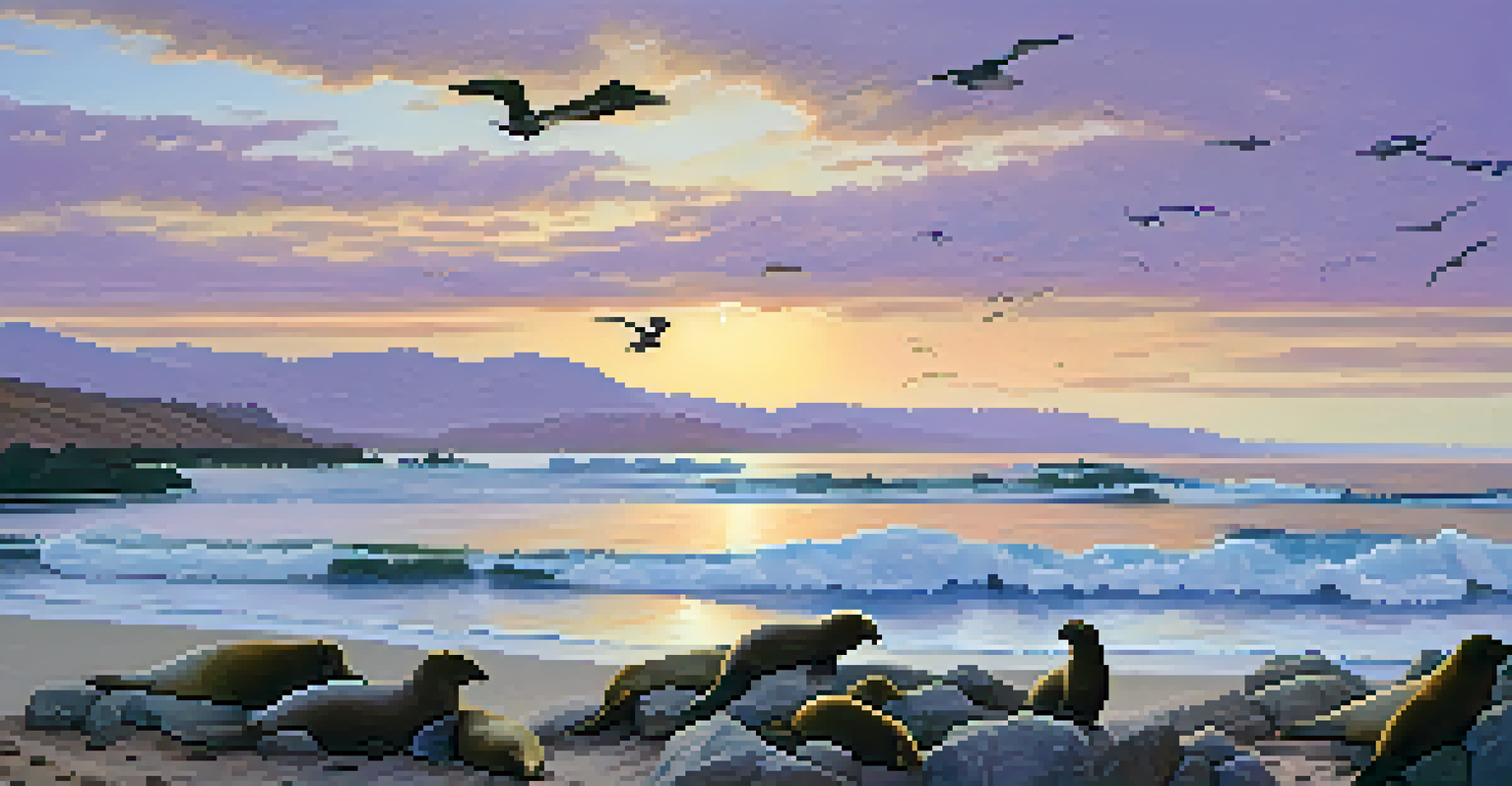Wildlife Photography: Capturing Peru's Natural Beauty Sustainably

Understanding Peru's Diverse Ecosystems for Photography
Peru is a treasure trove of biodiversity, featuring ecosystems ranging from the Amazon rainforest to the Andes mountains. Each region offers unique wildlife and landscapes, making it a photographer's dream. Understanding these ecosystems is crucial; for instance, the Amazon is home to countless species of birds, mammals, and reptiles, while the Andes showcase stunning high-altitude vistas.
In every walk with nature one receives far more than he seeks.
When planning your photography adventure, research specific locations that highlight these diverse environments. Think about places like Manu National Park for its rich flora and fauna or the Colca Canyon for breathtaking mountain views. This knowledge not only enhances your photography but also deepens your appreciation for Peru's natural beauty.
Additionally, being aware of seasonal changes can help you capture wildlife at its most vibrant. For example, the wet season often brings lush landscapes and more active wildlife, while the dry season allows for clearer skies, perfect for landscape shots.
Essential Gear for Capturing Wildlife in Peru
Choosing the right gear is vital for successful wildlife photography, especially in a place as diverse as Peru. A versatile camera with a good zoom lens allows you to capture distant animals without disturbing them. Consider bringing a tripod as well, which can help stabilize your shots, particularly in lower light conditions.

In addition to your camera, pack extra batteries and memory cards, as you don’t want to miss capturing a fleeting moment due to technical difficulties. A good pair of binoculars can also enhance your experience, letting you scout for wildlife before setting up your shot.
Explore Peru's Unique Ecosystems
Peru's diverse ecosystems, from the Amazon to the Andes, provide stunning photography opportunities and a deeper appreciation for nature.
Lastly, don’t forget about the importance of protective gear. Weather in Peru can be unpredictable, so waterproof bags and lens covers will keep your equipment safe while you're out in the field.
The Importance of Ethical Wildlife Photography
Ethical wildlife photography is about more than just taking stunning pictures; it involves respecting the animals and their habitats. This means avoiding actions that could disturb wildlife or damage their environment. For example, keeping a safe distance from animals ensures that they don't feel threatened and behave naturally.
Photography is the story I fail to put into words.
Additionally, it's essential to educate yourself about local wildlife laws and guidelines. Many areas in Peru have specific regulations in place to protect endangered species and their habitats. Following these rules not only enhances your experience but also contributes to the conservation of these precious ecosystems.
Moreover, consider supporting local conservation efforts through your photography. Whether it’s donating a portion of your profits from prints or volunteering your time, every little bit helps in the fight to protect Peru’s natural beauty.
Best Locations for Wildlife Photography in Peru
When it comes to wildlife photography in Peru, several locations stand out for their incredible beauty and rich biodiversity. The Amazon Basin, particularly in areas like Tambopata National Reserve, offers opportunities to capture jaguars, macaws, and countless other species in their natural habitat. Each moment spent here feels like a page out of a nature documentary.
The coastal regions, such as Paracas National Reserve, are equally captivating. You can photograph sea lions, penguins, and a variety of seabirds against stunning ocean backdrops. The unique landscapes along the coast provide a different perspective on Peru's wildlife.
Ethical Practices in Wildlife Photography
Respecting wildlife and their habitats is crucial for ethical photography, ensuring that both animals and environments are preserved.
Lastly, don't overlook the Andes mountains, where you can capture high-altitude animals like the Andean condor or the elusive vicuña. Each region offers a new adventure and countless opportunities to frame Peru's natural beauty.
Capturing Cultural Elements in Wildlife Photography
While wildlife is the main focus, integrating cultural elements into your photography can enrich your storytelling. Peru is home to a rich tapestry of indigenous cultures, many of which have deep connections to the land and its wildlife. Capturing moments that highlight this relationship can add depth to your work.
For instance, photographing local communities engaging in traditional practices can provide context to the wildlife that surrounds them. This approach not only enhances your photography but also honors the people who have lived in harmony with nature for generations.
Additionally, consider documenting local conservation efforts led by these communities. By showcasing their work, you can help raise awareness about the importance of preserving both wildlife and cultural heritage.
Post-Processing Tips for Wildlife Photography
Editing your wildlife photos can be just as important as the shoot itself. Post-processing allows you to enhance the colors, clarity, and overall impact of your images. Software like Adobe Lightroom and Photoshop can help you bring out the stunning details in your landscapes and wildlife shots.
Start with basic adjustments such as exposure, contrast, and color balance. These tweaks can significantly improve the vibrancy of your images, making them pop in a way that reflects the beauty of Peru’s landscapes. However, be careful not to over-edit; maintaining a natural look is key.
Integrate Culture into Your Photos
Capturing cultural elements alongside wildlife can enrich your storytelling and highlight the deep connections between local communities and nature.
You might also want to explore cropping techniques to improve composition and focus on your subject. Remember, the goal is to highlight the beauty of the wildlife and their habitat, so keep it as authentic as possible.
Sharing Your Wildlife Photography Sustainably
Once you've captured your stunning wildlife images, sharing them responsibly is crucial. Social media platforms are great for showcasing your work, but consider the impact of your posts. Avoid geotagging specific locations to prevent overcrowding and potential harm to these sensitive areas.
Instead, focus on sharing the story behind your photos. Talk about the experiences you had in the field, the importance of conservation, and the beauty of Peru's ecosystems. This approach can inspire others to appreciate and protect these environments.

Additionally, consider submitting your work to conservation organizations or publications that align with your values. This not only spreads awareness but can also contribute to the ongoing efforts to protect Peru's natural beauty for future generations.